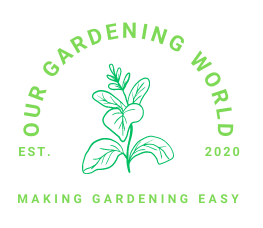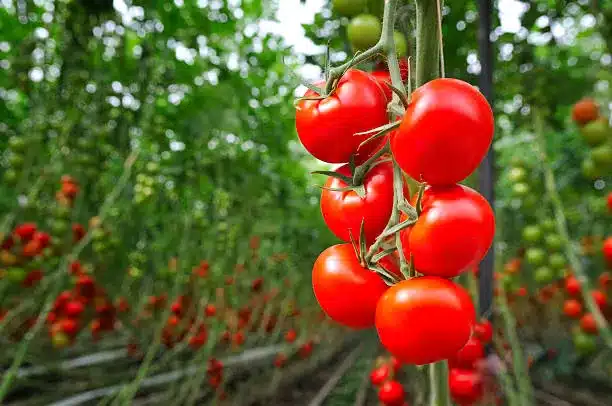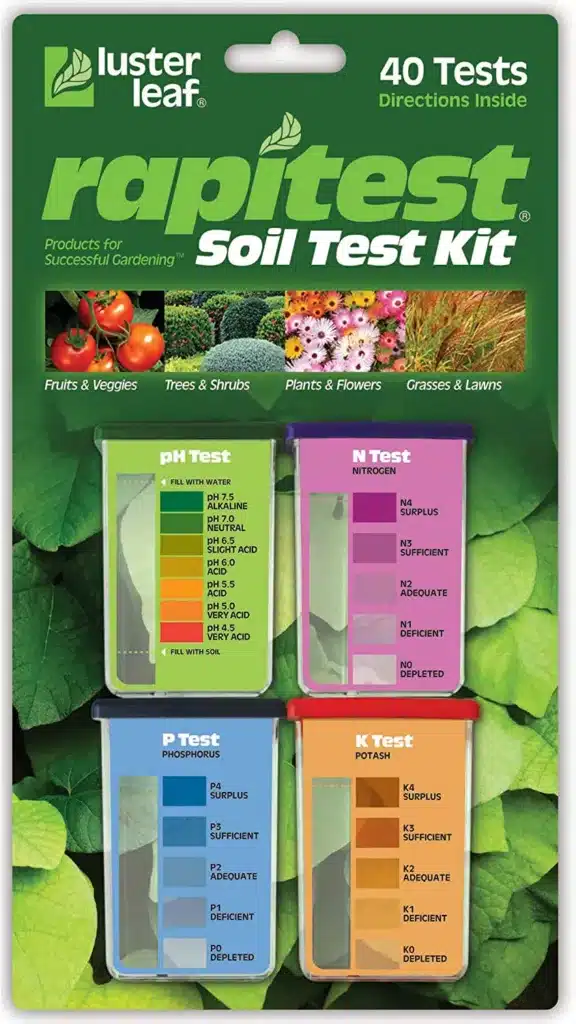Uncover the secrets of tomato plant growing in this ultimate beginner’s guide! From seed selection to harvest, become an expert in your backyard garden with these easy, effective, and fun gardening tips.
Unlocking the Mysteries of Tomato Plant Growing

Hello, fellow garden enthusiasts and green thumbs in the making! Have you ever found yourself at a farmer’s market or your local grocery store, eyes caught by the vivid red of a perfectly ripe tomato? Its skin taut and glossy, promising delicious juiciness and a flavor that screams of sunshine and earth. Have you held such a tomato in your hands and thought, “I wish I could grow these in my backyard”? Well, my friends, your wish is about to come true!
Welcome to the ultimate guide that unravels the secrets of growing tomato plants. It’s here that you’ll learn to cultivate your own bounty of tomatoes, perfect for salads, sauces, or a midday snack straight off the vine. This is more than just a wish now; it’s a project, a passion, and an incredibly rewarding journey that you’re about to embark upon.
In this guide, we’re going to explore the fascinating world of tomato plant growing, from the moment the seed meets the soil to the joyous occasion of your first harvest. Whether you have a sprawling backyard or a small urban balcony, we’ll show you how to make the most of your space to reap a jaw-dropping harvest. We’ll discuss varieties, preparation, planting, care, and finally, harvesting and enjoying the fruits of your labor.
So strap in for an adventure, filled with learning, excitement, a little bit of challenge, and a whole lot of juicy, delicious tomatoes grown by you. This isn’t just about adding another dish to your table; it’s about enriching your life, connecting with nature, and experiencing the unparalleled joy of growing your own food. By the time you’ve read through this guide, you won’t just be a gardener. You’ll be a tomato plant growing enthusiast, ready and equipped to produce a bounty that will make your neighbors green with envy!
So, let’s dive in and unearth the secrets to bountiful tomato plant growing. Welcome to your ultimate journey to becoming a master of the backyard harvest!
The Magic Starts with the Seed: Choosing the Right Tomato Plant Variety
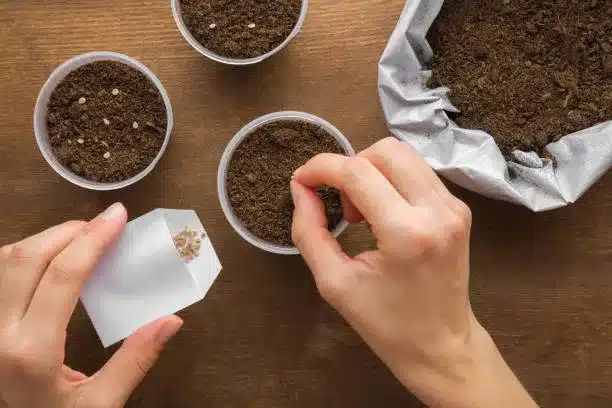
Tomato plants are a fascinating lot. They are diverse, vibrant, and come in a staggering array of shapes, sizes, and colors. From the small, bite-sized cherry tomatoes perfect for a quick snack or salad topping, to the hefty beefsteak varieties that make for a hearty sandwich filling, there is a tomato for every taste and purpose. Some varieties offer a sweet, almost fruity tang – perfect for fresh eating, while others boast a robust, acidic flavor that makes them the stars of homemade sauces and pastes.
But the first, and arguably the most crucial secret to successful tomato plant growing, lies in choosing the right variety. Now, you might wonder, what makes a variety ‘right’? Well, there are a few factors to consider here, and each is essential in its own right.
Climate Consideration
First off, you need to consider your local climate. Tomatoes love warmth, but the degree of heat and humidity they can tolerate varies. Some varieties are bred to withstand the sweltering heat of southern climates, while others fare better in cooler, northern regions. Determinate or ‘bush’ types, for example, tend to do well in regions with shorter growing seasons, as they produce all their fruit at once. On the other hand, indeterminate or ‘vining’ types can bear fruit over a longer period, making them a good choice for areas with longer growing seasons.
Tomato Plant Soil Suitability
Next, consider your soil. While tomatoes aren’t overly fussy about soil types, they do best in well-drained, fertile soil rich in organic matter. Some varieties, however, can tolerate less-than-ideal conditions better than others. For instance, certain heirloom varieties have been passed down through generations because of their adaptability to local soil conditions.
Culinary Preferences
Finally, consider your kitchen habits. Do you often find yourself making sauces or soups? Or do you prefer your tomatoes fresh in salads and sandwiches? Your cooking style can significantly influence your variety choice.
Sauce tomatoes, like Roma, have less water content and are excellent for cooking, while slicer tomatoes like the Beefsteak, with their size and juicy flesh, are perfect for eating fresh.
Choosing the right variety isn’t a decision to be made on a whim. It’s an exciting part of the process that involves a bit of research and possibly some advice from your local nursery or garden center.
Remember, you’re not just selecting a plant; you’re choosing a future culinary partner, a source of your next great meal.
So take your time, explore your options, and choose a variety that suits not just your garden’s physical conditions, but also your palate and cooking needs. It’s your first step towards a successful tomato plant growing experience.
A Strong Foundation: Preparing Your Soil for Tomato Plants
Like a house needs a strong foundation to stand tall and sturdy, tomato plants require well-prepared soil to grow and bear fruit prolifically. They adore well-drained, nutrient-rich soil, and when given this fertile ground to grow in, they will reward you with a bountiful harvest.
However, soil preparation isn’t simply about turning the ground and putting the plants in; it’s about creating an environment where your plants can thrive. One of the secrets to a successful tomato plant growing is enriching your soil with organic matter. But what does this mean, and how do you do it?
Adding Organic Matter To Your Tomato Plant
Organic compost and well-rotted manure are like the secret sauce to a rich and productive soil. These not only provide your plants with necessary nutrients but also help improve the soil’s structure, enhancing its ability to hold and drain water. This balance of moisture retention and drainage is particularly vital for tomato plants, as waterlogged soil can lead to root diseases, while dry soil can stress the plants.
If you have a compost pile at home, excellent! You have a treasure trove of nutrient-rich organic matter at your disposal. Mix this compost into your garden soil a few weeks before you plan to plant your tomatoes. If you don’t have a compost pile, don’t worry. Well-rotted manure is another fantastic source of organic matter. You can often purchase it from local farms or garden centers.
Testing and Adjusting Soil pH
Another crucial aspect of soil preparation is pH balancing. The pH level of your soil can significantly impact nutrient availability for your plants. For tomato plants, slightly acidic soil, with a pH between 6.2 to 6.8, is ideal. But how do you know your soil’s pH level? This is where a soil test comes in handy.
- Quick, at home results for Soil pH, Nitrogen, Phosphrous and Potash
- Innovative and inexpensive soil test kit features an easy-to-use capsule system and patented color comparators
- Contains all components needed for 40 tests. 10 for each of pH, N, P and K
- Simple, detailed instructions included. Great for beginners and experienced gardeners alike.
- Soil pH preference list for over 450 plants included
Soil testing kits are easily available at garden centers and online, and they’re simple to use. By following the kit’s instructions, you can quickly determine your soil’s pH level. If your soil is too acidic (a pH below 6.2), you can raise the pH by adding garden lime. Conversely, if the soil is too alkaline (a pH above 6.8), you can lower the pH with sulfur.
Making these amendments to your soil might seem like an extra step, but it’s a worthwhile investment. By investing time in soil preparation, you’re setting your tomato plants up for success.
You’re creating a nurturing environment where they can put down roots, grow strong, and eventually, bear those juicy, mouth-watering fruits you’re looking forward to.
So, get that compost ready, test your soil, make the necessary adjustments, and prepare to lay a strong foundation for your tomato plant growing journey!
Green thumb 101: 6 fascinating facts on composting for beginners
Welcome, budding environmentalist! You’ve taken a fantastic first step towards sustainable living by exploring the world of composting. In this beginner’s guide, we’ll be revealing six exciting… Read More >>

The Perfect Spot: Choosing the Ideal Location for Your Tomato Plant
Tomato plants are like the sunbathers of the plant world. They absolutely adore the warmth and brightness of the sun. A tomato plant basking in sunlight is a sight to behold; its leaves reaching out to soak in the golden rays, its stems standing strong, ready to bear the weight of soon-to-be-growing fruits. However, for your tomato plant to reach its full potential and yield a generous harvest, it requires a specific set of sunlight conditions. So, how do you ensure your tomato plants are getting the sun exposure they need?
Sunlight Requirements
On a basic level, your tomato plants need a good dose of daily sunlight – at least six to eight hours to be precise. Sunlight plays a crucial role in photosynthesis, the process by which plants produce food. Without enough sunlight, your tomato plants may struggle to produce fruit or yield smaller, less flavorful tomatoes. So, when selecting a spot in your garden for your tomato plants, make sure it’s an area that gets plenty of sunlight throughout the day.
Understanding Heat-Loving vs. Heat-Tolerant
However, while tomatoes are heat-loving plants, they’re not necessarily heat-tolerant. Yes, they thrive in warm, sunny conditions, but they have their limits. You may think, “The more sun, the better, right?” Well, not quite. Intense, scorching midday summer sun can be too much for tomato plants to handle. It can cause the plants to wilt, the leaves to burn, and the fruits to develop sunscald, a condition where patches of the tomato skin become discolored and tough.
Striking a Balance: Shielding from Intense Sun
So how do you strike a balance between providing ample sun exposure while protecting your plants from the harsh midday sun? Location planning and, when needed, a little bit of shading can go a long way.
When choosing a location for your tomato plant, try to select a spot that gets morning sun and is shielded from the intense midday sun, perhaps by a nearby tree or building. If that’s not possible, creating a simple shade cloth structure can help.
A shade cloth with 30-40% shade density can filter out the harsh rays while allowing enough light for the plants.
Remember, growing tomato plants is about providing them with the right conditions for growth. Just like us, they enjoy basking in the sun, but too much of a good thing can be harmful.
By understanding the sunlight needs of your tomatoes and selecting the ideal location, you’ll set your plants up for a successful, bountiful harvest. So scout out your garden, find that perfect spot, and let your tomato plants enjoy the sun-kissed life they love!
Shower Them with Care: Watering, Feeding, and Pruning Your Tomato Plants
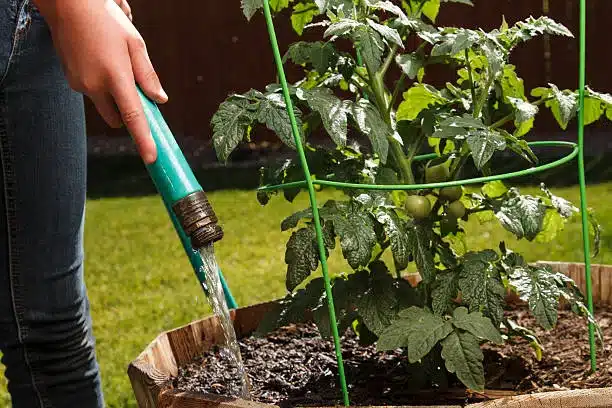
You’ve chosen your tomato variety, enriched your soil, and found the perfect sunny spot for your plants. Now comes the crucial part – the ongoing care.
Much like caring for a pet or a child, taking care of your tomato plants requires a bit of time, attention, and a whole lot of love. But with the right balance of watering, feeding, and pruning, you can ensure your plants are happy, healthy, and ready to reward you with a generous bounty of delicious tomatoes. Let’s delve into these care aspects one by one.
Watering: The Life-Giver
Water is vital to any plant, and tomatoes are no exception. Regular, deep watering is especially crucial during dry spells when natural rainfall isn’t enough to keep the soil moist. Deep watering means allowing the water to penetrate deep into the soil, encouraging the plant’s roots to grow down, enhancing its stability and access to soil nutrients.
However, tomato plants are a bit like Goldilocks when it comes to watering – they like it just right. Too little water, and the plant can become stressed, leading to issues like blossom end rot. On the other hand, too much water can drown the roots, leading to diseases like root rot. The secret is to keep the soil consistently moist but not waterlogged. If you’re unsure, a general rule of thumb is to water the plants when the top inch of soil feels dry to the touch.
Feeding: The Nutrient Boost
Tomatoes aren’t just big fruit producers; they’re also heavy feeders. They have a voracious appetite for nutrients, especially during the fruiting stage. To meet these nutritional needs, consider using a high-quality tomato fertilizer. These fertilizers are specially formulated with the right nutrient ratio to promote healthy growth and abundant fruiting.
When you apply the fertilizer, follow the package instructions for the correct quantity and frequency. Typically, you would start feeding the plants once they start to set fruit and continue throughout the growing season. Remember, over-fertilization can be just as harmful as under-fertilization, so moderation is key.
Pruning: The Optional Advantage
Pruning, while not a necessity, can provide several benefits to your tomato plants. Pruning involves removing specific parts of the plant, usually the suckers, the small shoots that emerge at the junction between the main stem and the branches.
Pruning can improve air circulation around the plants, reducing the risk of diseases. It can also direct more of the plant’s energy towards fruit production, potentially leading to larger, healthier tomatoes. However, remember that pruning should be done carefully, as over-pruning can stress the plant and reduce your overall harvest.
Caring for your tomato plants isn’t just a task; it’s a journey of understanding and responding to their needs. By watering wisely, feeding appropriately, and pruning judiciously, you can nurture your plants from tiny seedlings to full-grown, fruit-bearing wonders. So put on your gardening gloves, grab your watering can and pruning shears, and get ready to shower your plants with the love and care they deserve.
The Final Countdown: Harvesting Your Tomato Plant
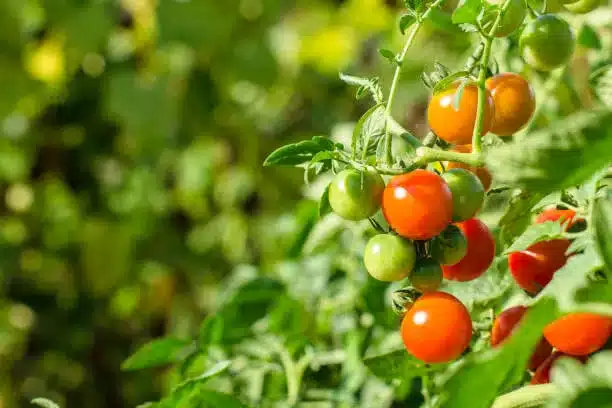
You’ve been patient, caring for your tomato plants with all the dedication and love you could muster. And now, it’s finally time for the payoff. The fruits of your labor (quite literally!) are ready to be plucked and savored.
The moment of truth – the harvesting – has arrived. But how do you know when your tomatoes are ripe and ready to be harvested? And how should you go about it to ensure the maximum yield and minimum plant damage? Let’s unlock these final secrets to tomato plant growing.
Identifying Ripeness
Ripe tomatoes have a few telltale signs. First, the color – your tomatoes should exhibit a uniform, vibrant color all over. The exact shade depends on the variety, ranging from the classic deep red to yellow, orange, green, or even purple. But no matter the variety, a uniformly colored tomato is a sign it’s ready to be plucked.
Another clue lies in the texture of the fruit. Ripe tomatoes have a slight firmness when gently squeezed. They should yield to your touch without feeling mushy or overly hard. If you’ve never felt a ripe tomato before, don’t worry. With a little experience, you’ll quickly get the hang of it.
Gentle Picking
Harvesting tomatoes is a delicate task. You don’t want to yank them off the vine and risk damaging the plant or the fruit. Instead, hold the fruit gently in your hand and twist it until it snaps off at the stem. If you find the fruit difficult to remove, you can use a pair of garden shears or scissors to cut the stem just above the fruit.
Harvest Early If Needed
Keep in mind that tomatoes can continue to ripen off the vine, so if you see bad weather on the horizon or the fruit is threatened by pests, don’t hesitate to harvest early. Place these early harvested tomatoes on a sunny windowsill or in a paper bag with an apple or banana (these fruits emit ethylene gas that aids ripening) until they’re ripe and ready to eat.
Harvesting your tomatoes is the grand finale of your tomato plant growing journey. It’s the moment when all your hard work pays off in the form of vibrant, flavorful fruits. So savor this moment, handle your fruits gently, and remember – each tomato you pick is a testament to your effort, care, and gardening skills. Here’s to a successful harvest and many delicious meals to come!
Growing tomato plants can be a rewarding experience, not just for the bountiful harvest, but also for the joy of watching something grow from a tiny seed to a fruit-bearing plant. So don’t wait, start your tomato plant growing journey today, and reap the fruits (literally!) of your labor.
Conclusion: Cultivating Your Green Thumb with Tomato Plant Growing
By now, you should have a better understanding of tomato plant growing and the secrets to achieving jaw-dropping harvests. Remember, gardening is a journey filled with discovery, patience, and sometimes, a bit of trial and error. But with these tips in mind, you’re well on your way to becoming a tomato plant growing expert.
Happy Gardening!

Hi there, I’m Mark Apletree, a gardening enthusiast with a passion for gardening, and gardening tools. I’ll be your go-to guide for all things related to gardening. The purpose of this website is to assist you in selecting the most suitable garden gear that meets your specific requirements.
See All Posts